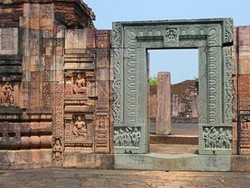Puphagiri
Puphagiri (Also Puspagiri Mahavihara) was one of the earliest buddhist mahavihara spread across Cuttack and Jajpur district, Odisha (ancient Kalinga) in 3rd century AD and flourished until the 11th century in India. Today, its ruins lie atop the Langudi hills, low hills about 90 km from the Mahanadi delta, in the Jajpur and Cuttack district in Odisha. The actual mahavihara campus, spread across three hilltops, contained several stupas, Monasteries, temples, and sculptures in the architectural style of the Gupta period. The Kelua river, a tributary of the Brahmani river of Odisha flows to the north east of Langudi hills, and must have provided a picturesque background for the mahavihara. The entire mahavihara is distributed across three campuses on top of the three adjoining hills, Lalitgiri, Ratnagiri, and Udayagiri.
Puphagiri ranks along with Nalanda, Vikramshila and Takshila universities as one of the primary institutions of higher learning in ancient India. The three universities were mentioned in the travelogues of the famous Chinese traveller Xuanzang (Huien Tsang), who visited it in 639 CE, as Puphagiri Mahavihara, as well as in medieval Tibetan texts. However, unlike Takshila and Nalanda, the ruins of Puphagiri university were not discovered until 1995, when a lecturer from a local college first stumbled upon the site. The task of excavating Puphagiri's ruins, stretching over 143 acres (0.58 km2) of land, was undertaken by the Odisha Institute of Maritime and South East Asian Studies between 1996 and 2006. It is now being carried out by the Archaeological Survey of India (ASI). The Nagarjunakonda inscriptions also mention about this learning center.
ASI has launched a major conservation effort, and as of 2007, in the process of acquiring more land in the university's vicinity. Once fully unearthed, the site is expected to become a significant international tourist destination in India. The state government has initiated an annual Buddha Mahotsava at the site.
There are other Buddhist attractions around Langudi hills, the site of Puphagiri. Kaima hill in its immediate vicinity contains a unique rock-cut elephant surrounded by four monolithic khondalite pillars, and dates back to the Mauryan period in the 3rd century, B.C. Deuli, a hill situated in the confluence of the Brahmani and Kimiria rivers, has preserved five rock-cut Buddhist chambers inside Caves. Some more Buddhist sites have also been discovered at Bajragiri, Sarapur and Paikrapur. The Langudi sites are perhaps the largest historic Buddhist complex in India.
Langudi can be approached from Jaraka and Chandikhol on the National Highway 5, and are easily accessible from the urban centres of Cuttack and Bhubaneswar. The best months to visit the place would be during October and February. History
As of 2007, the ruins of this Mahavihara have not been fully excavated yet. Consequently, much of the Mahavihara's history remains unknown. Of the three Mahavihara campuses, Lalitgiri in the district of Cuttack is the oldest. Iconographic analysis indicates that Lalitgiri had already been established during the Sunga period of the 2nd century BC, making it one of the oldest Buddhist establishments in the World.
